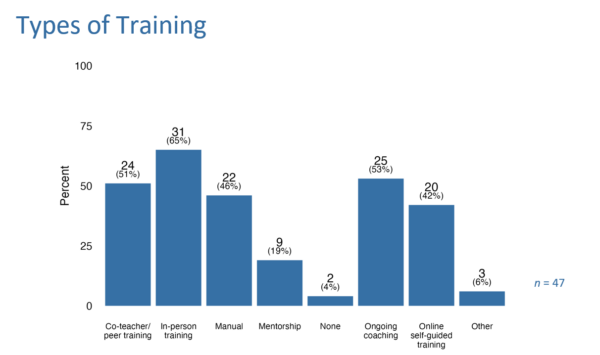By Erin A. Chaparro, Haley E. Johnson, Dylan Kriescher, and Brad Rentz
Most educators are aware of the steep decline in student performance levels due to the pandemic. They have either observed the skill deficits in their schools or read the most recent results of the National Assessment of Educational Progress (NAEP) report, which details declines in math and reading for students in grades 4 and 8 (Nation’s Report Card, 2022). The trend is no different in the four states we serve—Nebraska, North Dakota, South Dakota, and Wyoming—with reading and math scores declining or remaining steady from 2019 to 2020 (Nation’s Report Card, 2022).
In response, educators across the country are targeting student skill deficits through multiple methods. One way is using American Rescue Plan Funds allocated to state departments of education to support the implementation of evidence-based programs and practices to help catch students up to grade-level performance standards. Some of the commonly discussed options for the supplemental funding include extended school days, summer school programs, and tutoring both during the day and after school. Many of these strategies fall under the umbrella of accelerated learning strategies. The implementation of accelerated learning strategies and programs optimize data and resources to ensure students have the supports they need to succeed at grade level.

The Region 11 Comprehensive Center (R11CC) worked to support states in our region by better understanding the implementation of accelerated learning strategies in Nebraska, North Dakota, South Dakota, and Wyoming. Our team looked to existing research as well as the field of implementation science practice to develop a survey for building principals. We created the principal survey with the end goal of learning the who, what, and how of accelerated learning programs across the region. We based survey questions on known best practices for accelerated learning (Short & Hirsh, 2021; The New Teacher Project, 2021), including the use of data to:
- create intentional action plans and goals,
- efficiently and effectively distribute resources and assess effectiveness of programming,
- identify appropriate intensity of instruction, and
- provide additional support and resources for educators.
Participants
We sent the survey directly to 1,524 principals, also disseminating the survey via our state partners, the R11 newsletter, and Twitter. A total of 65 principals (North Dakota, n = 5; Nebraska, n = 32, South Dakota, n = 11, Wyoming, n = 17) participated in the survey. The principals are leaders in 35 secondary schools, 29 elementary schools, and one K–12 school. Most principals were from rural districts (n = 57) with only a few (n = 8) from urban districts.
Survey Findings
In the survey, we asked principals to tell us about the accelerated learning program that was the most developed or exemplary. We wanted to understand the focus of these programs as well as their implementation strategies, data use practices, and professional development supports.
While the sample size offers only a snapshot of school-level activity, we can present several trends from the data:
» Content areas. When asked which content areas accelerated learning programs targeted, most principals reported literacy (n = 40), math (n = 32), and writing (n = 20).
» Instructors. Most principals (85%) reported that classroom teachers are the primary instructors for accelerated learning practices. Additionally, 36% of principals mentioned instructional aides as accelerated learning instructors and 21% of principals reported computer programs as the next most common source of instruction.
» Team-led implementation. Most principals (68%) reported that a dedicated team oversaw implementing the accelerated learning programs in their building. Those teams reviewed data (90%), monitored student progress (83%), problem-solved implementation issues (77%), monitored fidelity (48%), and offered coaching or professional development (45%). The members of these teams included administrators and classroom teachers most of the time (87% and 96%, respectively) but also included instructional coaches and specialists some of the time (35% and 41%, respectively).
» Data-use practices. Fifty-seven percent of principals collected program fidelity data. Those principals reported that fidelity data was collected monthly (37%), weekly (25%), or quarterly (25%) with the remaining reporting that data was collected semiannually or annually. Principals reported the teams reviewed the data monthly (44%), semiannually (22%), quarterly (18%), or weekly (14%). Fidelity data was reviewed to:

- determine if a program was working (85%),
- place or group students based on their needs and to identify individual student achievement strengths and weaknesses,
- help identify where staff needed additional training and support, and
- to adjust programming to better align with student needs.
» Professional learning. We asked principals what types of training opportunities were available for teachers and instructors of the accelerated learning programs. Principals reported that in-person training (65%), ongoing coaching (53%), co-teacher or peer training (51%), online self-guided training (42%), instructor’s manual (46%), or mentorship (19%) were the most common types of learning opportunities available. A few principals reported the use of professional learning communities as well as making funds available if teachers wanted to pursue additional professional development opportunities. Only 4% of principals reported that no training was available for teachers and instructors delivering accelerated learning programs.
A limitation of the results shared here is that the survey summary is not representative of all schools in Region 11. Because only 65 principals completed the survey we can only interpret this summary as a snapshot of these 65 schools. We thank these principals from across the region who gave us these valuable insights. For the principals who did complete the survey, we can say that the practices they reported, such as collecting and using data to make decisions and offering professional learning opportunities, are in alignment with the suggested best practices for implementing accelerated learning programs.
Erin A. Chaparro, Ph.D., Former Research Director, McREL
Haley E. Johnson, Ph.D., Researcher, McREL
Dylan Kriescher, Ph.D., Researcher, McREL
Brad Rentz, Ph.D., Senior Researcher, McREL
